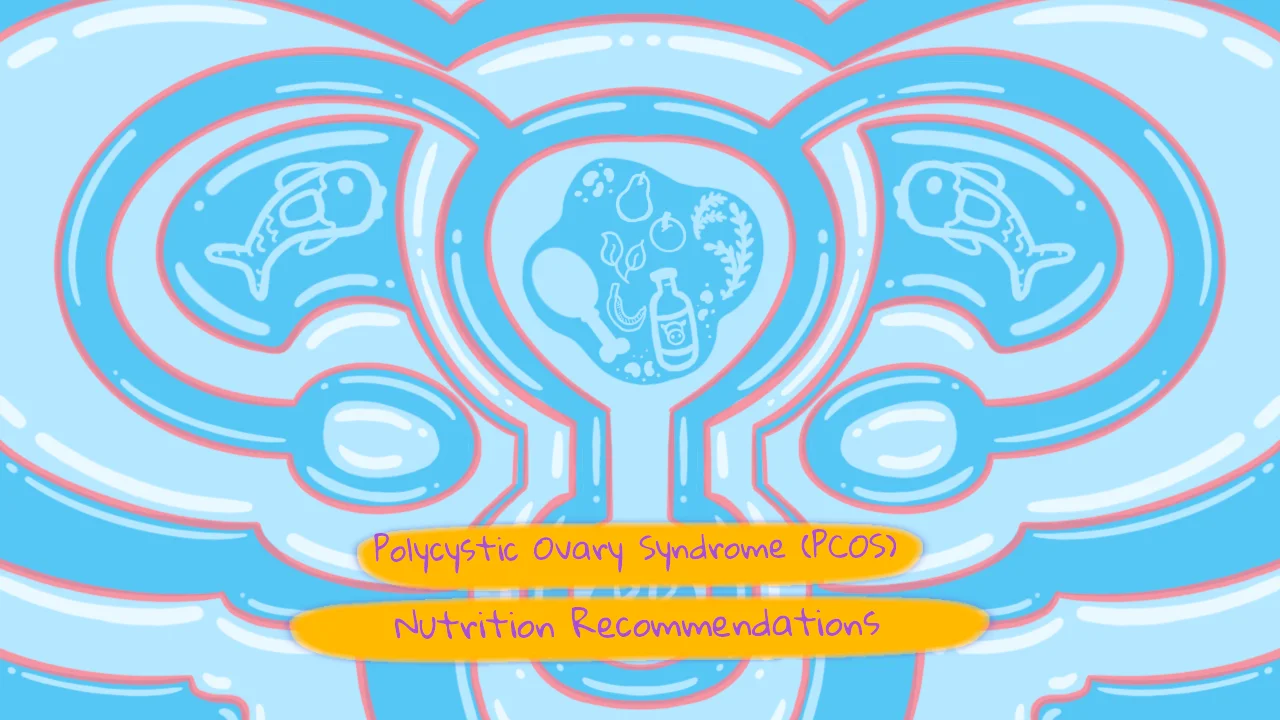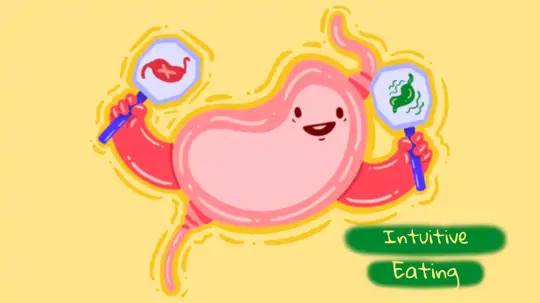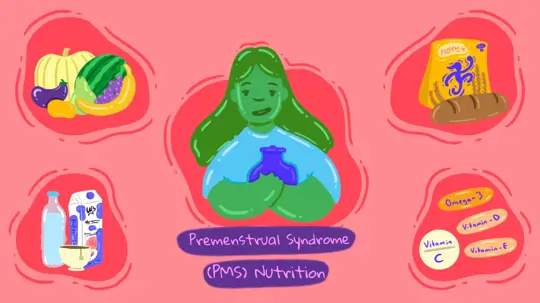
Start feeling better today!
Connect with your therapist today and take control of your life like our 850.000 happy clients.
Get StartedWhen we look at the cause of diseases or treatment methods, we observe that the treatments that reduce or prevent symptoms are through nutrition and lifestyle. This is pleasing because it shows that we can be in a more advantageous position against diseases by adjusting the changeable conditions we have. In this article, we will talk about a syndrome that especially affects women of reproductive age.
Let's take a closer look at polycystic ovary syndrome.
Problems such as menstrual irregularities, hair growth especially in the chin area, or weight gain can be frequently seen in women of reproductive age. Polycystic ovary syndrome is the most common endocrine disorder affecting 15-18% of women of reproductive age. Its definition was changed in 2003 with the Rotterdam criteria. We can define polycystic ovary syndrome, or PCOS, as a heterogeneous group containing different phenotypes. Treatment should be done with a personalized approach because these phenotypes can change with weight gain or can be present in the same person1.
Despite its high prevalence, polycystic ovary syndrome is generally not treated. A recent international study into the cause shows that approximately 50% of women visit 2 or more health professionals to receive a diagnosis of polycystic ovary syndrome, and it can take close to 2 years to receive a diagnosis. In fact, women with polycystic ovary syndrome do not have cysts in their ovaries, but rather small immature follicles. These can often be confused with cysts.
When we look at the physiological basis of this syndrome;
Ovulation and maturation of egg follicles depend on the harmonious functioning of the hypothalamus-pituitary gland-ovaries. Inflammatory cytokines are also secreted from the increased fat tissue and the chronic inflammation in polycystic ovary syndrome is fed.
Women with polycystic ovary syndrome face many health risks during most of their reproductive years. The increase in fat tissue causes low-level inflammation. Sugar consumption and saturated fats increase oxidative stress, supporting insulin resistance and hyperandrogenism. Chronic androgen exposure also increases cellular deterioration and inflammation3.
The first approach to managing the risks of polycystic ovary syndrome should be lifestyle changes.
Polycystic Ovary Syndrome and Age
Polycystic ovary syndrome was once considered a reproductive problem, but it is now defined as an endocrine disorder that causes type 2 diabetes, metabolic syndrome, cardiovascular disease, and cancer in later stages. Half of women with PCOS develop prediabetes or type 2 diabetes by the age of 40. Metabolic complications worsen with age, and the risk of developing diabetes increases.
PCOS's Relationship with Eating Disorders and Mental Health
It has been shown that women with polycystic ovary syndrome are at higher risk of anxiety and depression than women without polycystic ovary syndrome. They experience more mood swings due to imbalanced hormones. Patients with polycystic ovary syndrome who experience anxiety or depression should definitely be referred to a mental health professional4.
A study found that women with polycystic ovary syndrome have a 4 times higher risk of developing disordered eating behaviors than the control group. Increased insulin levels are linked to binge eating behaviors and increased cravings. According to a study published in the journal Apetite, 60% of obese women with polycystic ovary syndrome have binge eating behaviors5.
Polycystic ovary syndrome is a very common disorder that reduces the quality of life in women's daily lives, creates reproductive disorders, and makes them more prone to depression and anxiety.
Best Nutritional Strategies for PCOS
Although the optimal diet for polycystic ovary syndrome has not yet been defined, diet and lifestyle changes are the primary treatment for women with polycystic ovary syndrome.
In a systematic study published in the Journal of the Academy of Nutrition and Dietetics, metabolic and reproductive parameters were significantly improved thanks to weight loss.
Eating a lower glycemic index and glycemic load diet or well-planned carbohydrate, fat and protein amounts appeared to improve metabolic markers even without weight loss6.
Proper Diet and Nutrition for PCOS
When choosing the best diet for women with polycystic ovary syndrome, when the symptoms of women and the markers that best reveal their metabolic status according to the studies conducted were examined, it was determined that insulin levels and inflammatory markers were higher in women with polycystic ovary syndrome compared to those without.
In a study conducted in 2015, researchers discovered the use of an anti-inflammatory diet in women with polycystic ovary syndrome.
In this study, 100 overweight women with polycystic ovary syndrome were fed a lower calorie diet for 12 weeks.
The content of this diet is a 5-meal plan consisting of 25% protein, 25% fat and 50% carbohydrates. This diet;
The results of this study are encouraging. The women who participated in the study lost approximately 7.2% of their weight, and significant decreases were observed in cholesterol, blood pressure, and fasting blood sugar levels. C-reactive protein (CRP) levels, which indicate inflammation in the blood, decreased by 35%, and menstrual periods returned in 63% of women.
The DASH diet, used for hypertension patients, has also been studied in women with polycystic ovary syndrome. Women who followed this diet for 8 weeks experienced significant decreases in insulin and CRP levels, and also had narrowing of waist circumference measurements7.
Nutrition and lifestyle strategies are of critical importance in the management of polycystic ovaries. Low glycemic index diets, anti-inflammatory foods, and regular physical activity make significant differences for PCOS.
Lifestyle Changes Against PCOS
Lifestyle changes are the first step in the treatment of polycystic ovaries.
Nutrition and Diet in PCOS
There are many types of diets for the treatment of hormonal changes, especially when we look at studies conducted on women with polycystic ovary syndrome, it has been observed that reducing calories and diets that will not increase blood sugar are effective. In this context, ketogenic diet and low glycemic index diet can be preferred because they contain low carbohydrates and do not increase blood sugar. But let's not forget that it is essential to get the opinion of a nutritionist and doctor who will evaluate you for the best diet plan.
In diet studies conducted on patients with polycystic ovary syndrome, reducing calories and following a low glycemic index diet have provided beneficial results. Thanks to the low glycemic index diet;
Another type of diet, the ketogenic diet, has been found to be effective for metabolic syndrome, hormone imbalances, and weight loss. It has been observed that it has serious health benefits in patients with PCOS. Nutritional counseling is one of the treatment methods for patients with polycystic ovary syndrome8.
Physical Activity in PCOS
Today, physical activity and exercise have become more accepted in the treatment of diseases. We can say that exercise also provides serious benefits in the management of polycystic ovary syndrome. Depending on the intensity of the exercise, high-intensity exercises are the most effective exercise in terms of insulin resistance and body composition and cardio respiratory health. A minimum of 120 minutes of aerobic activity per week can be recommended to these patients. If you ask what type of exercise is more healing, intense aerobic and resistance exercises are useful for increasing insulin sensitivity and improving increased androgen levels. It has also been observed that it can significantly reduce the HOMA-IR value and BMI value, which help us monitor insulin resistance9.
Use of Supplements in PCOS
The issue of food supplements is especially prominent in polycystic ovary syndrome. Let's take a look at which supplement will positively affect which mechanism without creating too much confusion.
According to research, the most effective supplements are as follows;
1. N-acetylcystine
NAC is both a powerful antioxidant and an amino acid. It is the precursor of glutathione. It has a critical role in oxidative stress and combating inflammation. It also protects insulin receptors. It affects insulin receptor activity and insulin release from the pancreas. The therapeutic dose has been determined as 1.6-3 grams per day.
In a systematic review and meta-analysis, body mass index, total testosterone, insulin and blood lipid levels were as effective as metformin. It was also seen to regulate ovulation and increase the chance of pregnancy10.
2. Inositol
Forms of inositol have been studied extensively in women with PCOS. As a result of the studies, it is possible to say that it is promising. The MYO-inositol form is effective in increasing egg quality, especially insulin sensitivity, and regulating ovulation.
In addition to supplements, inostol is actually found in foods. It is a pseudovitamin found especially in foods such as fruits, beans, grains, and buckwheat. Inositol forms also help support hormonal activity11.
3. Vitamin D
Studies reveal that vitamin D has a serious connection with metabolic and hormonal disorders. Vitamin D receptors are found in oocytes. Monthly 100,000 IU of vitamin D has been observed to improve fertility by increasing the number of mature follicles and menstrual regularity in women with PCOS12.
4. Fish Oil
Fish oil helps lower increased triglyceride levels, improves fatty liver and reduces inflammation. Fish oil also lowered testosterone levels in both overweight and normal weight women with androgen excess and irregular menstrual cycles, and improved and regulated the menstrual cycle.
5. Vitamin B 12
In extensive studies on diabetes, it has been observed that metformin affects the absorption of vitamin B 12. Vitamin B 12 deficiency may occur in long-term metformin users. Metformin use is quite high in women with polycystic ovaries. Patients using metformin should check their B-12 levels and supplement if necessary; the methyl-cobalamin form is the best absorbed form.
6. Sleep
Some mental disorders can be seen as comorbidities in women with this syndrome. Sleep disorders, anxiety and depression are the most important of these. Sleep disorders are among the most important causes of anxiety and depression in polycystic ovaries. In addition, not getting enough sleep increases the risk of developing insulin resistance, obesity and diabetes. Inadequate sleep is associated with factors such as hormonal changes, inflammation and deterioration of the intestinal barrier.
Melatonin is a very good antioxidant. Melatonin levels are reduced in patients with polycystic ovary syndrome and they cannot benefit from this antioxidant, which protects ovarian follicles from free radicals. Sleep disorders seriously complicate the management of polycystic ovary syndrome. Therefore, improving sleep and ensuring sleep hygiene makes a significant difference in treatment13.
If we want to group and summarize the foods that help control polycystic ovary syndrome;
Polycystic ovary syndrome is a complex disorder that can cause long-term metabolic risk factors. With diet and lifestyle changes becoming the primary treatment, dietitians play an important role in helping women with polycystic ovaries.
References
- Effects of exogenous adiponectin supplementation in early pregnant PCOS mice on the metabolic syndrome of adult female offspring – Zuo et al. - Journal of Ovarian Research - 2021
- IMPROVE lifestyle in polycystic ovary syndrome: a systematic strategy – Del Pup & Cagnacci - Gynecological Endocrinology - 2021
- High glycemic index diet in PCOS patients. The analysis of IGF I and TNF-α pathways in metabolic disorders – Szczuko et al. - Medical Hypotheses - 2016
- Polycystic Ovary Syndrome and Eating Disorders—A Literature Review – Góral et al. - Journal of Clinical Medicine - 2024
- Effects of Dietary Glycemic Index and Glycemic Load on Cardiometabolic and Reproductive Profiles in Women with Polycystic Ovary Syndrome: A Systematic Review and Meta-analysis of Randomized Controlled Trials – Kazemi et al. - Advances in Nutrition – 2021
- DASH Diet, Insulin Resistance, and Serum hs-CRP in Polycystic Ovary Syndrome: A Randomized Controlled Clinical Trial – Asemi & Esmaillzadeh - Hormone and Metabolic Research – 2014
- Women with PCOS on keto diet may see improvements in fertility – Endocrine Society – Link
- Effects of aerobic, resistance, and combined exercise training on insulin resistance markers in overweight or obese children and adolescents: A systematic review and meta-analysis – Marson et al. - Preventive Medicine – 2016
- N-Acetylcysteine for Polycystic Ovary Syndrome: A Systematic Review and Meta-Analysis of Randomized Controlled Clinical Trials – Thakker et al. - Obstetrics and Gynecology International – 2015
- Myo-inositol effects in women with PCOS: a meta-analysis of randomized controlled trials – Unfer et al. - Endocrine Connections – 2017
- Serum Vitamin D Levels and Polycystic Ovary Syndrome: A Systematic Review and Meta-Analysis – He et al. - Nutrients – 2015
- The role of melatonin in polycystic ovary syndrome: A review – Mojaverrostami et al. - International Journal of Reproductive BioMedicine (IJRM) - 2019




